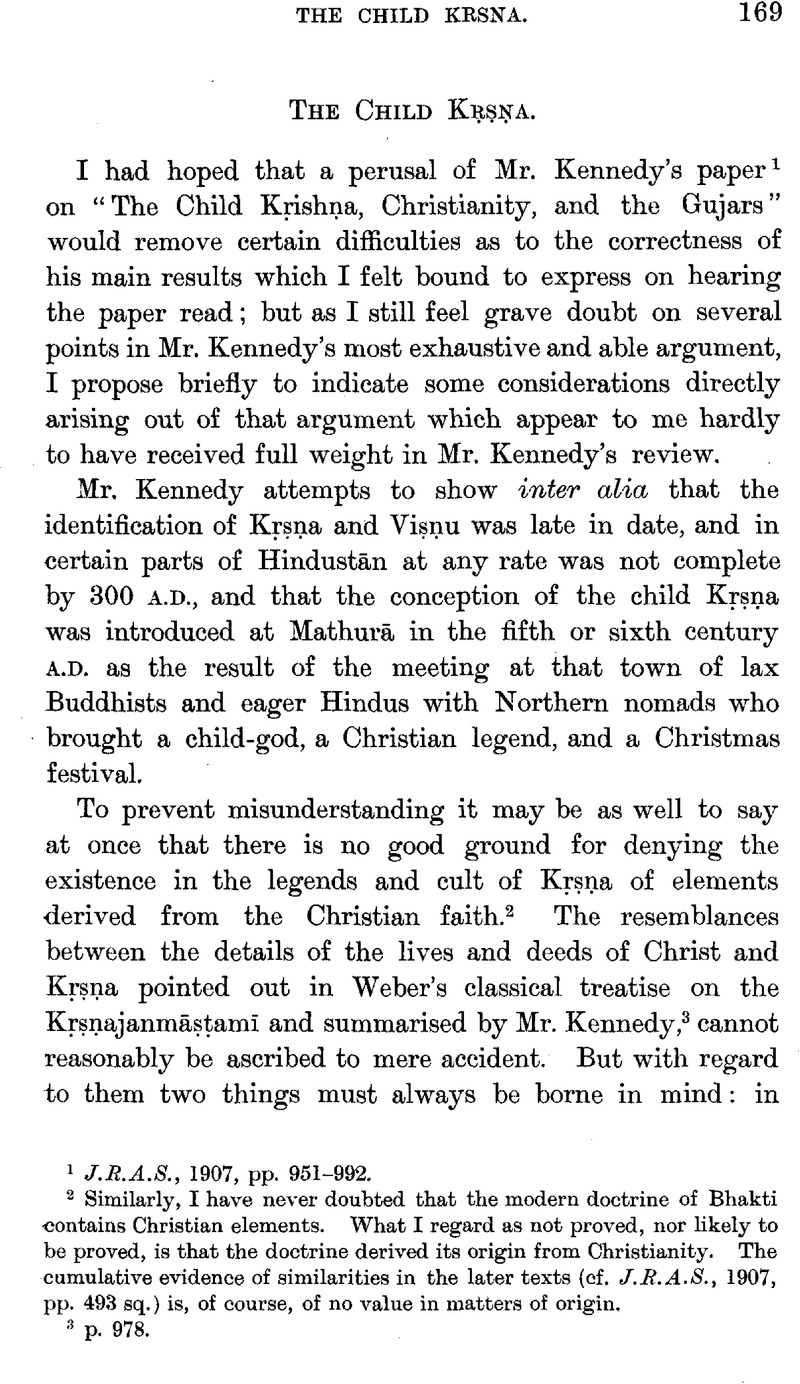No CrossRef data available.
Published online by Cambridge University Press: 20 February 2017

page 169 note 1 J.R.A.S., 1907, pp. 951–992.Google Scholar
page 169 note 2 Similarly, I have never doubted that the modern doctrine of Bhakti contains Christian elements. What I regard as not proved, nor likely to be proved, is that the doctrine derived its origin from Christianity. The cumulative evidence of similarities in the later texts (cf. J.R.A.S., 1907, pp. 493 sq.) is, of course, of no value in matters of origin.Google Scholar
page 169 note 3 p. 978
page 170 note 1 p. 963
page 171 note 1 For the real importance of sun-worship in India, of. Manucci's emphatic testimony (Storia do Mogor, trans, by Irvine, , iii, p. 3)Google Scholar
page 171 note 2 But Nārāyaṛa, Vāsudeva, and Viṣṇu appear as identified in TaittirĪya ĀraŇyaka, x, 1, 6 (see Weber, , Ind. Stud., i, p. 78; xiii, p. 353Google Scholar), and the date of that passage can hardly be later than the third century B.C. It is probably much earlier, and any account of Viṣṇu must take note of it.
page 172 note 1 Ind. Stud., xiii, p. 352.Google Scholar
page 172 note 2 Op. cit., p. 491. For the importance of Viṣṇuism in the growth of the drama, cf. Lévi, Théâtre indien, pp. 316 sq.Google Scholar
page 172 note 3 See Weber, , op. cit., p. 489, n. 3.Google Scholar
page 172 note 4 Op. cit., p. 335.Google Scholar Lévi, (op. cit., p. 315) inverts the attributions of colour, but this is quite illegitimate.Google Scholar
page 172 note 5 Usener, : Archiv f. Religionswissenschaft, 1904, pp. 297–313.Google Scholar Such a contest occurs in the Vedic Mahāvrata. Cf. Oldenberg, , Religion des Veda, pp. 444, 445, 506.Google Scholar
page 173 note 1 J.R.A.S., 1907, p. 681.Google Scholar
page 173 note 2 On PāŇini, iii, 2, 111:Google Scholar jaghāna Kaṃsaṃ kila Vāsudevaḥ; on ii, 3, 36Google Scholar: asādhur mātule Kṛṣṇaḥ; and the Kaṃsavadha, on iii, 1, 26Google Scholar. See Weber, , op. cit., pp. 353 sq.Google Scholar The connection of Kṛṣṇa and DevakĪ must be very old if, as seems most probable, the Kṛṣṇa DevakĪputra of the Chāndogya Upaniṣad, iii, 17, 6, is a euhemerism.
page 174 note 1 Weber, , op. cit., p. 355.Google Scholar
page 174 note 2 Cf. Whitney, , Sanskrit Grammar2, p. 424, and the form govinduGoogle Scholar, ibid., p. 444; Maedonell, , Vedic Grammar, p. 115.Google Scholar
page 174 note 3 Altindische Grammatik, i, p. lii.Google Scholar The form might even be for gopĪndra (Pischel, , Prākrit Grammar, p. 72), and record the connection of Kṛṣṇa and the GopĪsGoogle Scholar
page 174 note 4 J.R.A.S., 1907, p. 933.Google Scholar This assumes that Kṛṣṇa was originally a vegetation spirit, and then by a natural transition (which has parallels in Greek religion, as in the case of Dionysos) the god who is sometimes incarnate in an animal becomes the deity which acts as guardian of the herds. Kṛṣṇa's birth in a stable may be derived from this side of his character, which, to some extent, justifies Barth's view that this point in his history is independent of Christianity (cf. Hopkins, , India, Old and New, p. 165).Google Scholar Hopkins (op. cit., p. 147)Google Scholar lays stress on the heroic element in the divinity of Kṛṣṇa, but though it is certainly possible that Kṛṣṇa is merely a hero who has grown into a great deity, it must be remembered that vegetation spirits often appear as heroes, as probably in the case of Erechtheus at Athens, Hyakinthos in Sparta, etc.
page 175 note 1 Théâtre indien, p. 314;Google Scholar Quid de Græcis veterum Indorum Monumenta tradiderint, pp. 16, 38.Google Scholar So Oldenberg, , Die Literatur des alten Indien, p. 138.Google Scholar
page 175 note 2 See Kielhorn, , GÖtt. Nachr., 1885, pp. 185 sq.;Google Scholar Bühler, , Die indischen Inschriften, p. 72.Google Scholar The only substantial argument yet adduced against the generally accepted date of Pataņjali is the possibility that the examples whence the argument for his date is derived may be mÜrdhābhiṣikta (cf. Weber, op. cit., p. 319Google Scholar). The lower limit of date, 60 A.D., given by Weber (op. cit., p. 319)Google Scholar, cannot, however, be supported by the date of Abhimanyu, as the date of that king (if he ever existed) is quite uncertain. See also my Aitareya Araṇyaka, pp. 21–25.Google Scholar